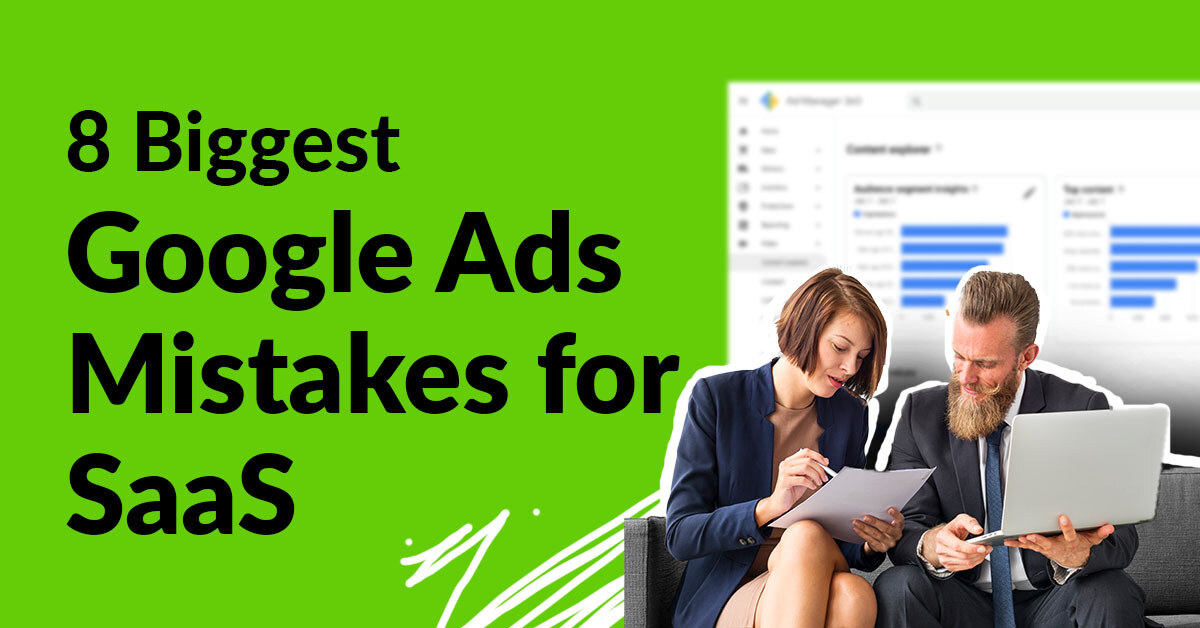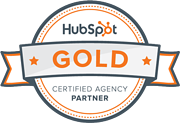When it comes to Google Ads, B2B SaaS companies often face unique challenges that ecommerce or other B2C brands can avoid. The buyer’s journey in the world of B2B SaaS marketing is longer and more complex, since it can require getting approval from numerous different stakeholders – whereas B2C brands usually only have to convince a single person to get a conversion. Despite the immense advertising potential of Google Ads, many B2B SaaS brands struggle to make it a profitable challenge, for one major reason:
They’re doing it wrong!
Well, okay, that “one major reason” is actually a bunch of smaller reasons that all add up. In this blog, we’ll look at the most common mistakes that B2B SaaS companies make when using Google Ads – and how you can avoid them.
Mistake #1: Prioritizing Informational Over Commercial Intent
Let’s say that you’re a project management software brand. You’re searching for keywords for your Google Ads – and wouldn’t you know it, “what is project management software” has tons of search volume. You run ads targeting this keyword, but don’t see much in the way of results.
Why is that? You were targeting such a high-volume keyword, after all. The issue is that you used a keyword demonstrating informational intent, rather than commercial intent. “What is project management software” is a phrase that could be used by anybody looking to understand the concept; this might have high traffic, but these users probably aren’t ready to purchase.
Educational and informative content and keywords can attract a larger audience, but it often fails to drive conversions. “What is CRM” or “how to manage customer data” are keywords that might make for great blog posts – but in Google Ads, they probably won’t result in qualified leads.

How to Fix It:
Prioritize commercial intent keywords that might have lower volume than their informational counterparts, but which are much more likely to lead to a purchase. A better keyword for your project management software brand might be something like “best project management software for remote teams,” for example. These sorts of keywords are used by users who are actively comparing solutions – meaning that they intend to purchase one. These potential customers are much further down the buyer intent pipeline.
If you offer accounting software, use “best accounting software for small businesses” or “accounting tools for startups” over broader terms like “what is accounting software.”

One tip is to always make sure your keywords include commercial intent modifiers; these are terms that are more commonly used in commercial queries but less frequently in informational ones. Some common commercial intent modifiers include:
- Software
- Platform
- Tool
- Solution
- Service
- Best
- Top
- Compare
- Pricing
- Demo
- Vendor
- App
- Provider
- Online
- SaaS
If you add these modifiers to your keywords and your ad copy, you’ll significantly reduce irrelevant clicks and improve your Google Ads budget ROAS (return on ad spend).
Mistake #2: Not Segmenting Campaigns by Intent
In our previous section, we talked all about the need to prioritize commercial queries over informational ones. That means you shouldn’t target informational queries at all, right?
Well.. maybe.
The issue is that, as you’ve probably noticed, these keywords often have quite a bit of volume, and that’s volume that you can capture and use – it’s just volume that comes from a vastly different part of the buyer’s journey.
Still, there is often quite a bit of value in lower-intent keywords due to their higher volume. These can be useful terms to market to, but they should never be in the same campaign as your high-volume commercial intent keywords are. Segmenting out your keywords by intent lets you:
- Put more budget in the higher-value, BoFu (bottom of funnel) keywords, for greater ROAS, while allocating a smaller share of the budget for higher-volume, lower-converting keywords.
- Separate the destination landing page for these campaigns; BoFu keywords can direct to a landing page where the ultimate goal is to get users to sign up for a free trial in order to seal the deal, while ToFu (top of funnel) keywords could lead to an ebook or other gated informational resource that lets you answer the user’s query while collecting information like email addresses you can use to put them into a nurturing campaign.
How to Fix It:
Segment all of your keywords into at least two campaigns, one targeting BoFu, high-purchase-intent queries and the other targeting ToFu, informational-intent queries. You can also set up a third campaign targeting middle-of-the-funnel queries, if you want.
If you’re strictly concerned with conversions or have a more limited budget available, you can only run the BoFu campaign or campaigns – and those campaigns should get the lion’s share of your budget anyway.
Consider organizing your campaigns similarly to this:
- High Intent: These are keywords with clear purchase intent (e.g., “best email marketing platform” or “email marketing software demo”). Direct users to a landing page where they can sign up for a demo with your sales team or sign up for a free trial, with the aim of closing the deal and getting a conversion.
- Mid Intent: These keywords have some commercial intent but will require some nurturing (e.g., “email marketing platform features”). Direct users to an informational page that might, for instance, compare your platform to your competitors’ offerings and show why yours is superior.
- Low Intent: These are informational keywords meant for ToFu awareness (e.g., “how to start email marketing”). Direct users to a piece of informational content gated behind a contact form, like an ebook or white paper, so that you can start marketing to these people and move them down the pipeline.
Segmenting these campaigns will let you assign more budget to high-intent campaigns while not neglecting low-intent ones, improving your ROA. It will also let you track the performance of each intent category separately, so you can get a more accurate sense of how your target audience behaves.
Mistake #3: Not Auditing Your Campaigns
B2B SaaS Google Ads campaigns are like your automated sprinkler system – you can turn them on and then never check them again, because they will always work at maximum efficiency, right?
No. Not even close. (Also, for that matter, you probably should be checking your automated sprinkler system every once in a while, but that’s besides the point).
Google Ads for SaaS companies often can be inefficient because the team running the campaigns neglects to audit ad performance on a regular basis. This oversight can result in wasted ad spend on irrelevant queries or underperforming ads, an inefficiency that can compound over time to waste thousands or even millions of dollars, depending on your business’ size.
Are your search terms the most effective keywords you could be using? Is your ad copy – descriptions and headlines both – converting? Are your landing pages doing their jobs? Are your forms or CTAs properly optimized?
If you’re not regularly auditing your campaigns, you might be missing critical fixes to improve your conversion rates.
How to Fix This:
Regularly audit all parts of your campaigns. This includes things like:
- Excluding irrelevant search terms by adding them to negative keyword lists.
- Revising ad copy to better match user search intent – segmenting out campaigns makes this much easier, as we previously discussed – and highlight your unique value propositions.
- Ensuring your landing pages not only best align with the user’s search query, but that they provide a seamless user experience that drives the visitor to take the action you want them to take and doesn’t bounce off.
- Simplifying forms and testing different CTAs to optimize conversions.
- Sunsetting underperforming ads and replacing them with more highly optimized ones.
You can use tools like Google’s Keyword Planner and Search Term Report to identify and refine your keyword strategy regularly.
Also, if you’re using “Request a Demo” as your primary CTA (call-to-action) on your high-intent landing pages – and you’re not alone, it’s often the default CTA for B2B SaaS ads – you should reconsider this. It isn’t always the most effective CTA!

Some alternative CTAs you can consider include “Start my free trial,” “Get started,” “See it in action,” or “Talk with us.”
Mistake #4: Poor Budget Allocation
Mismanaging your Google Ads budget is a mistake that can be quite literally costly. Many B2B SaaS companies spread their budget too thin across low-performing campaigns, and consequently fail to invest adequately in their high-performing ones.
Fixing this mistake, of course, is downstream from the previous example. If you’re regularly auditing your campaigns, that’s just one part of the puzzle – the next part is to do something about it.
How to Fix This:
Adopt a data-driven approach to budget allocation. Start by identifying top-performing campaigns using Google Ads’ built-in data capabilities to find campaigns with high CTR and conversion rates. Conversely, identify struggling campaigns.
While you work to refresh and optimize the struggling campaigns, shift funds from underperforming campaigns to high-performance ones. This will help you optimize your ROAS.
Once you have optimized the underperforming campaigns, run small-scale tests on these new versions. If successful, scale them up and put budget back in so that they can run alongside the existing high-performing variants.
Mistake #5: Neglecting Retargeting

Given the longer sales cycle in the B2B SaaS marketing space, retargeting – reaching out to users who have already interacted with your brand so that they get multiple touchpoints – is a vital tactic to master B2B SaaS Google Ads performance. However, as we have previously noted on this blog, retargeting can be very difficult to do well.
What’s even worse, however, is not retargeting at all! “Warm” audiences – users who are familiar with your brand – convert at significantly higher rates than “cold” audiences who are hearing of you for the first time.
How to Fix This:
Start retargeting! Reach out to customers who have lapsed who you might be able to win back, or include your targeting on things like Google’s Display Ads network so that your ads are displayed to people who might have already interacted with your ads, visited your website, or wound up on one of your landing pages.
Consider using:
- Dynamic retargeting to serve ads showcasing specific features or benefits, based on a user’s previous interactions.
- Sequential messaging to gradually nurture prospects by addressing pain points and offering solutions.
- Cross-channel integrations to stay top-of-mind on platforms like YouTube or, through the Display Network, any other website these visitors might be using.
Retargeting ensures you don’t lose prospects who might not be ready to convert immediately. This is a great way to turn ToFu users making informational queries into mid- and bottom-funnel users who might be ready to make a purchase.
Here’s a tip – segment audiences for retargeting based on their actions, e.g., users who visited the pricing page but didn’t convert are much closer to making a final purchase than users who downloaded your white paper.
Mistake #6: Overlooking Landing Page Optimization
We touched on this in the “auditing your campaigns” section, but it’s important enough that it deserves to be considered a separate mistake all on its own.
No matter how effective your Google Ad campaigns are – no matter how tight your copy, no matter how well-optimized your keyword targeting, no matter how skillful your retargeting – sending traffic to a poor landing page can derail your efforts.
Common issues on a landing page include irrelevant content, poor user experience (UX), slow loading times, subpar mobile optimization, and unclear CTAs.
How to Fix This:
Spend time making sure your landing pages are as effective as they can possibly be. Optimize landing pages for:
- Relevance. The headline and content on a landing page should match the ad copy – visitors should be assured that what they clicked on is what they’re getting. You can use dynamic content to always match the content of the ad message.
- Speed and UX. The page should load within three seconds, and should be easy to navigate and scroll through, whether someone is on a desktop, a laptop, a tablet, or a smartphone. Most users are on mobile devices – accommodate them.
- Clarity. Use concise copy, bullet points, and visuals to quickly communicate value for a user who might not have much time.
- Trustworthiness. Social proof like testimonials, review scores, and trust badges can help potential users realize that your B2B SaaS business isn’t just fluff and buzzwords, but rather has helped plenty of people and brands just like theirs.
Consider A/B testing different elements of your landing pages, like headlines or form lengths, to identify which is the most effective. Tools like Hotjar or Google Optimize can help you identify issues with your landing pages, boosting the performance of your SaaS Google Ads.
Mistake #7: Not Targeting the Right Audience
Google Ads offers highly advanced audience targeting options, but many B2B SaaS companies don’t use these features to their full potential. Without precise targeting, your ads might be shown to irrelevant audiences, leading to wasted spend.
How to Fix This:
Use audience targeting features to refine your campaigns.
You can use custom audiences to target users based on specific search behaviors; account-based marketing (ABM) lets you focus on key stakeholders at specific companies or industries you’d like to target; In-Market Audiences target users who are actively researching solutions in your category.
Mistake #8: Overlooking the Competition
It would be nice if your SaaS B2B competitors didn’t try to promote their brands at all, letting you easily overtake them in market share, wouldn’t it? Of course, that’s not what’s happening. Your competitors are advertising on many – if not all – of the same channels that you are, and not tracking their offerings is a great way to wind up with them eating your lunch.
The opposite, of course, is also true: Understanding how your competitors are positioning their offerings can provide invaluable insights into how you can market your own B2B SaaS brand.
How to Fix This:
Use tools like SEMRush or SpyFu to identify competitor keywords, discovering high-performance keywords your competitors are targeting – and running your own ads, potentially nabbing their traffic for yourself.

You can analyze their ad copy, studying how they structure their ads and highlight their selling points. What are they doing well? Where could you beat them?
Applying these insights can give your B2B SaaS Google Ads campaigns a real competitive edge. Look for gaps in their messaging or offerings and highlight those in your ad copy to further differentiate your solution.
(Always remember, however, that while you can bid on their branded keywords, you can’t use their name or logo in your ads – that’s a big no-no, and Google will usually pull those ads or penalize your business.)
Want to Avoid Making these Mistakes? Talk to the B2B SaaS Google Ad Pros
Google Ads can be a powerful tool for B2B SaaS companies – but it has to be used strategically. By avoiding common mistakes like the ones we outlined in this blog, you can make your campaigns significantly more profitable.
Remember, the key to success lies in understanding your audience and continuously optimizing and refining your approach. Mastering these takes time and effort, but you can get a shortcut by working with the pros.
Why not talk with a veteran B2B and SaaS marketing agency like SevenAtoms? We have decades of experience helping businesses just like yours find real customers, meet their growth goals, and succeed.
Contact us today for a free consultation on your B2B SaaS marketing campaigns and learn how we can help you achieve your goals.










